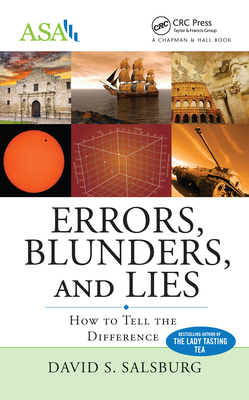You are here
Back to topErrors, Blunders, and Lies: How to Tell the Difference (Hardcover)
Description
We live in a world that is not quite "right." The central tenet of statistical inquiry is that Observation = Truth + Error because even the most careful of scientific investigations have always been bedeviled by uncertainty. Our attempts to measure things are plagued with small errors. Our attempts to understand our world are blocked by blunders. And, unfortunately, in some cases, people have been known to lie.
In this long-awaited follow-up to his well-regarded bestseller, The Lady Tasting Tea, David Salsburg opens a door to the amazing widespread use of statistical methods by looking at historical examples of errors, blunders and lies from areas as diverse as archeology, law, economics, medicine, psychology, sociology, Biblical studies, history, and war-time espionage. In doing so, he shows how, upon closer statistical investigation, errors and blunders often lead to useful information. And how statistical methods have been used to uncover falsified data.
Beginning with Edmund Halley's examination of the Transit of Venus and ending with a discussion of how many tanks Rommel had during the Second World War, the author invites the reader to come along on this easily accessible and fascinating journey of how to identify the nature of errors, minimize the effects of blunders, and figure out who the liars are.
About the Author
David Salsburg is the author of The Lady Tasting Tea: How Statistics Revolutionized Science in the Twentieth Century, a popular science book he wrote in retirement. It has appeared in hardcover and paperback, in Chinese, Korean, Japanese, and Portuguese editions. The paperback version is now in its eleventh printing. Since retiring in 1995, Salsburg has also taught at the Harvard School of Public Health and currently teaches one course a year at Yale University. He continues to publish academic articles.Salsburg was the first statistician hired by Pfizer Central Research, Pfizer Inc. in 1968. During his years at Pfizer, he worked on 15 successful products and hundreds of unsuccessful ones, and rose to the top of the company's scientific ladder. Salsburg occasionally taught courses at the University of Connecticut and at Connecticut College. His publication record includes more than 50 articles in refereed journals and three academic books. He was honored by being named a Fellow of the American Statistical Association, given a Lifetime Achievement Award from the Pharmaceutical Manufacturing and Research Association, and declared an outstanding alumnus from the University of Connecticut.He graduated from the University of Pennsylvania with honors in 1952, and served as an officer in the U.S. Navy 1952-1955. In the five years after serving in the Navy, he tried his hand at business. Salsburg married his wife, Fran, in 1959 and, with her encouragement, went back to school for graduate studies. He received a Master of Science in mathematics from Trinity College, Hartford, and a PhD in mathematical statistics from the University of Connecticut in 1966. Degree in hand, he accepted a position as an assistant professor in the Statistics and Operations Research Department of the Wharton School, University of Pennsylvania.
